Mega-Cities and hidden Buddhist Temples, a booming electrical industry and bustling farmers market, K-Pop and traditional Pansori chants – Korea is a land full of fascinating contrasts.
And since the country is not only incredibly varied but also quite different from the Western part of the world, travelling around Korea can be a bit overwhelming, especially for individual solo travellers who are not basically carried from place to place on a pre-organized tour. To make your entry into Korea a bit easier and smoother, I put together a sack of helpful info and tips that will make your Individual Solo Trip to Korea fun right from the start.
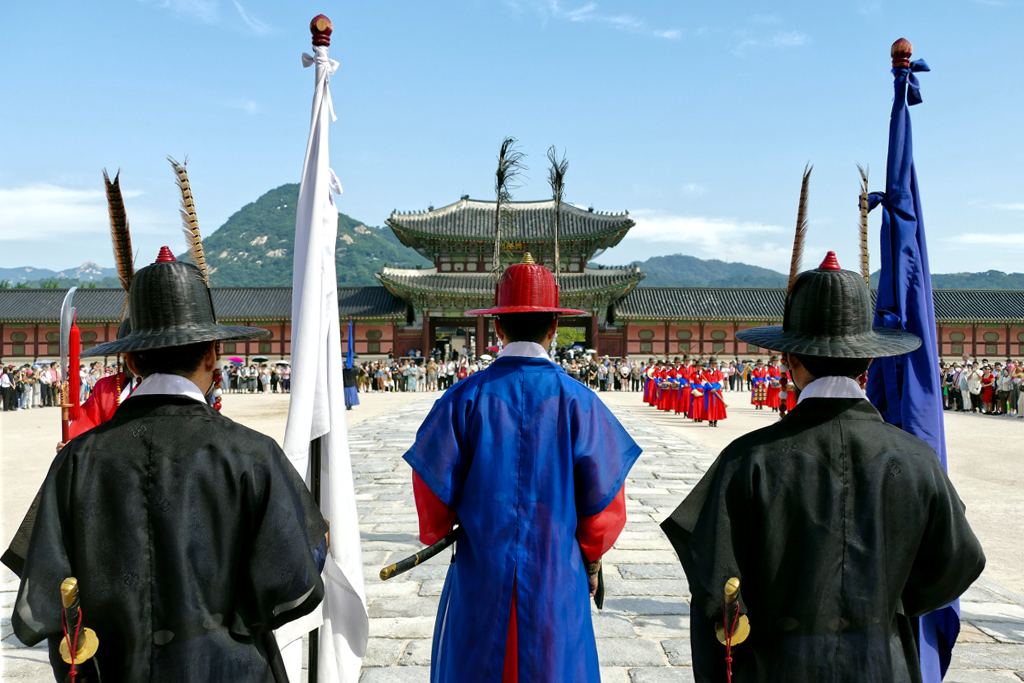
- 한국에오신것을 환영합니다 – Welcome to South Korea
- Travelling Solo
- Best Time to Visit
- Recommended Length of Stay
- Entry Requirements
- Cash And Cards
- T-Money Card
- Costs And Expenses
- SIM Cards
- Plugs and Voltage
- Indispensible Apps
- Language Barriers
- Safety
- Gastronomy Etiquette
- Ground Rules of Etiquette
- Travelling Around
- What to Know When Visiting a Korean SPA
- Bathrooms Everywhere
- This Is Not Japan
- Anything Else?
- Pinnable Pictures
한국에오신것을 환영합니다 – Welcome to South Korea
After my first recent trip to South Korea, I’m happy to supply you with tips and information about how the trip went for me as a Westerner and especially as a woman travelling alone.
Before the trip, I had of course done a bit of research into what to expect and how I should behave. I had been to Japan some time ago, and somehow I assumed that since Korea had developed economically in line with Japan, things might be similar in other areas too. And while this is true in some areas, rules can be very different in Korea; most importantly: They are far fewer of them and they are not as strictly followed as in the so-called Land of the Rising Sun.
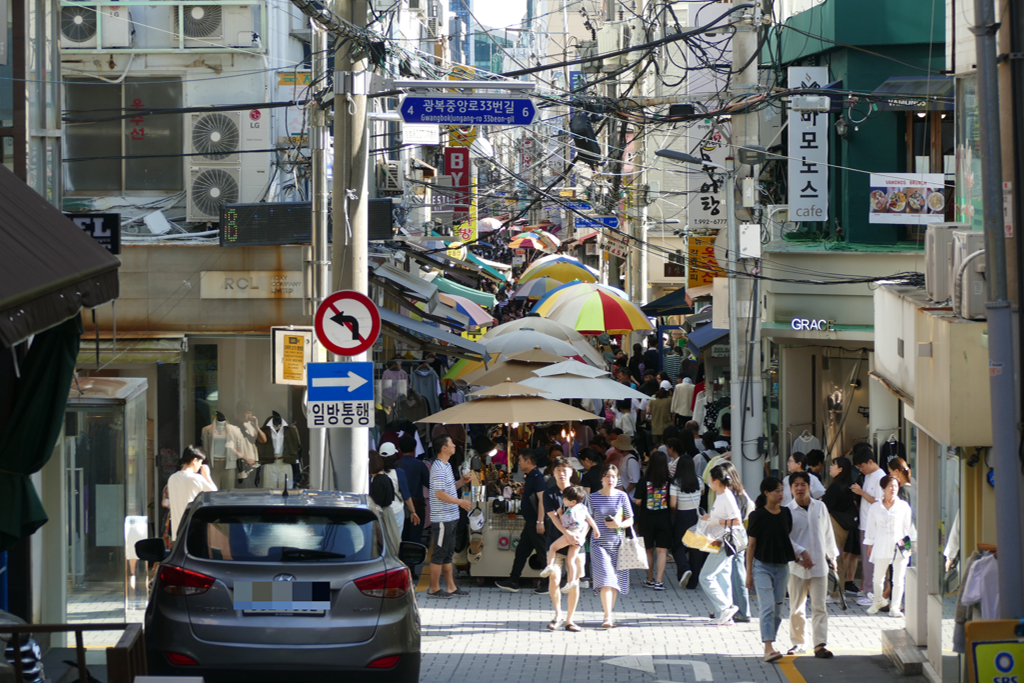
Koreans are nowhere near as reserved as Japanese. They may not shout around in the subway, but it is absolutely not taboo to chat and talk on the phone.
Although jaywalking is frowned upon, I spotted locals crossing the street whenever they pleased. And orderly queuing is theoretically a cherished idea, but some lines disperse very quickly when necessary and the survival of the fittest applies.
Travelling Solo
To answer the question of whether South Korea is a good country to explore on a solo trip is tricky. It strongly depends on which aspect of travel we’re talking about.
South Korea is an extraordinarily safe country. It is very unlikely that you will become a victim of petty crime. You don’t have to constantly guard your luggage like a gimlet. I am a veteran of solo travel and really enjoyed not having to have my guard up all the time.
So when we talk about the aspect of safe travel, Korea is an excellent country.
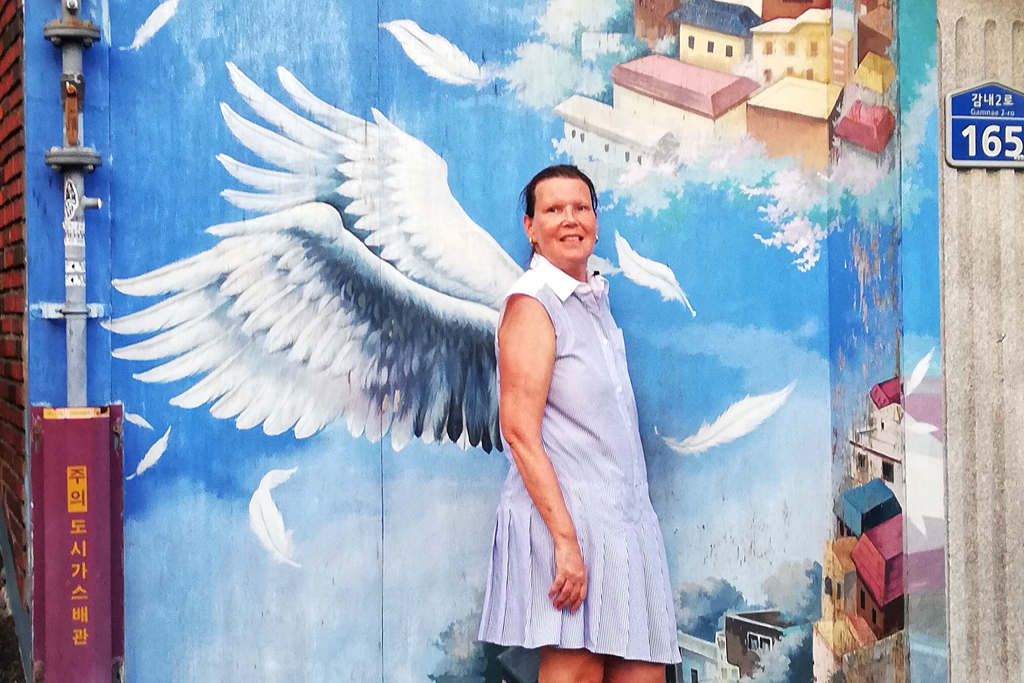
Now, there are other aspects of travel in which Korea performs rather poorly. One of them is communication. Savvy solo travelers will agree that just because you’re heading out alone doesn’t mean you don’t want to talk to anyone for weeks. On the contrary: Most of the solo travellers I have met on my many trips are very open, communicative, and sociable people. But the joy of communication is quickly dampened in a country where hardly any locals speak sufficient English.
Currently, Korea is taking measures to attract international visitors to the country. That’s why, for example, the K-ETA is currently suspended for citizens of 22 countries. That’s great, but foreign visitors are still far from being embraced by all Koreans. Westerners are aliens in Korea and are often viewed with skepticism. Mind you, Korea is a rather homogenous society with a rate of 3 percent foreigners of whom almost 50 percent are Chinese.
Couples Only
Also, Korea is an extremely couple-oriented society. Sadly, this makes travelling solo more difficult. While I’m used to paying at hotels based on the room and not on occupation, in Korea, even dining out solo tends to be very frustrating. I have been refused service several times in restaurants with the argument that they only serve two or more people. While I can accept this with a heavy heart and a growling stomach at places like Korean barbecues, I still don’t understand why I was denied a fish platter in Andong.
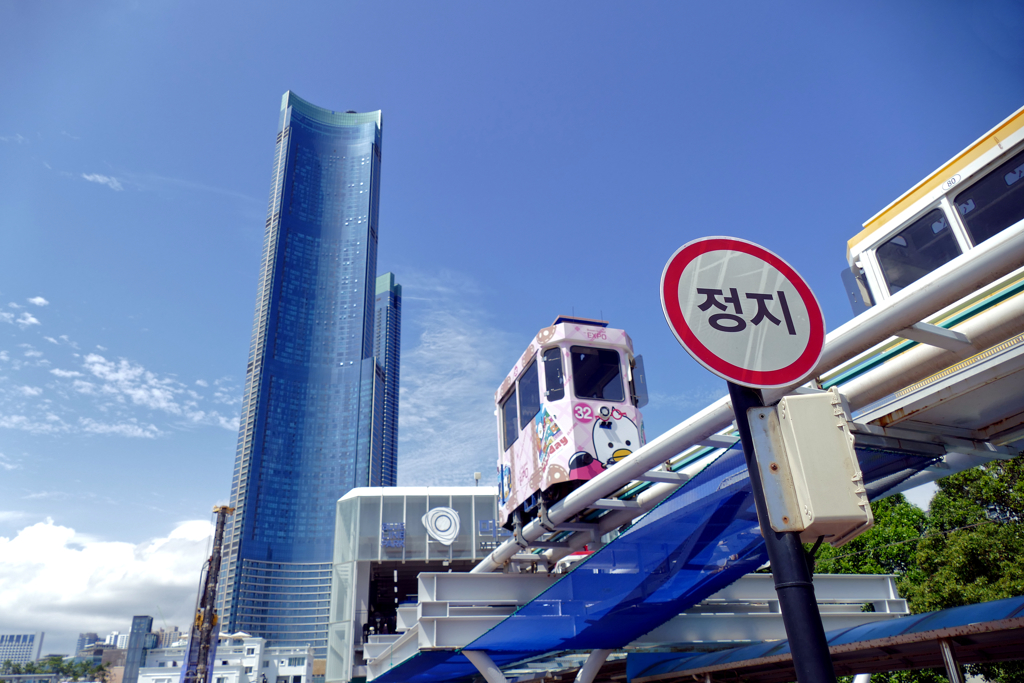
Even certain attractions are designed for couples or families only. Also, I sometimes had the impression that while solo-travelling men might have it a bit more complicated, for female solo-travellers it’s just pathetic.
It’s a Man’s World
In Korea’s patriarchal society, a single woman is inherently strange, if not suspicious. After all, in Korea, the greatest good is to marry well and then give birth to a son as quickly as possible. In a country where the wife has to cook for and look after the entire family at her in-laws’ house on certain holidays, a woman travelling cross-country alone is an alien. How much Korean society is focused on men is shown, for example, by the fact that hotel saunas are only for men. Although I paid the same price, I was excluded from certain services based on gender. I know of several countries where the equal opportunities officer would investigate.

The sense of immense inequality is not just based on my gut feeling or humble experience: With 31 percent, Korea has the highest gender pay gap in the entire world!
However, to get an insight into Korean life, I recommend the books Kim Jiyoung, Born 1982 by Cho Nam-Joo, and The Vegetarian by Han Kang. Literature can be incredibly eye-opening in a country where you cannot communicate with the locals due to language barriers, but also cultural impediments. And no, those K-dramas might be entertaining and fuel your wanderlust, but they won’t give you a realistic perspective.
Best Time to Visit
South Korea, like many other countries, has four seasons. In general, spring from April to early June is beautiful because the weather is pleasant and the flowers are in full bloom. Then, in autumn from September to November, it’s cooler again, and the country wears a beautiful dress of leaves in red, orange, and yellow.

During the winter months from December to February, Korea can suffer from Siberian temperatures. This time is only recommended for winter sports – but do you really have to go to Korea for that?!
July and August are not only unbearably hot, but it is also monsoon season with torrential rain. Hence, this is clearly not a good time to visit South Korea. Additionally, it’s also typhoon season, although most typhoons hit Japan and China.
Recommended Length of Stay
Of course, it’s best if you just meander through a country at your own pace. Wherever you lay your hat is your – temporary – home. But who has that luxury?! Therefore, it is difficult to advise on a length of stay. All I can say is that South Korea is an incredibly diverse country: there are exciting cities full of glitz and glamour, cult and culture, tradition and modernity. You could easily spend two weeks in cities like Seoul and Busan and still not see everything worth seeing. There are also small towns like Jeonju, Gyeongju, and Andong, which contain huge amounts of cultural assets in a small area.
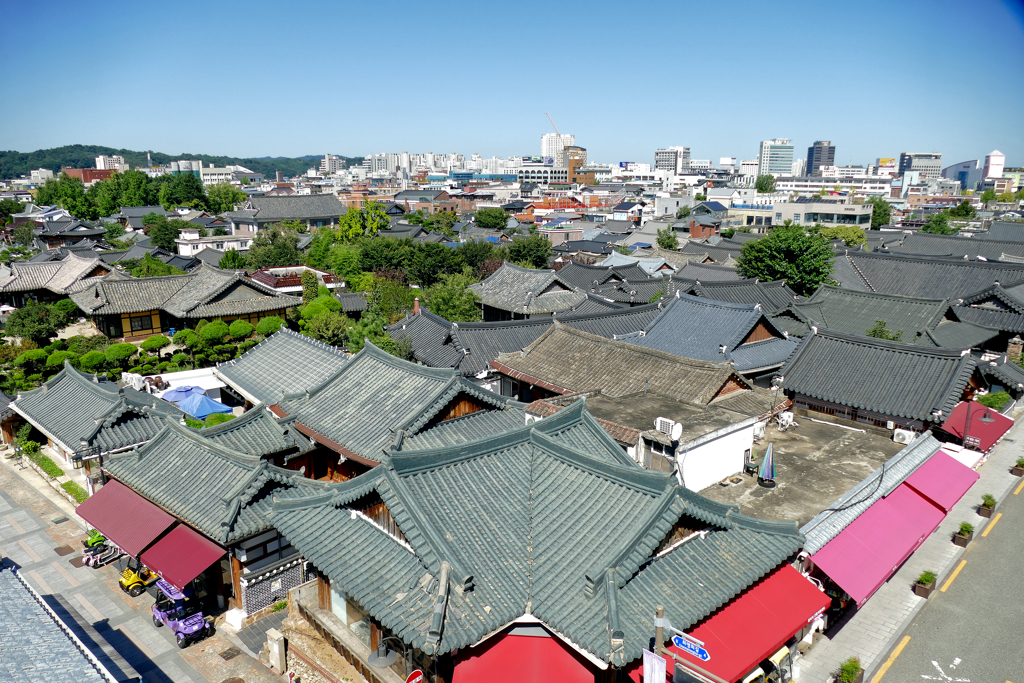
Hikers and nature lovers get their money’s worth in South Korea: hiking is the number one popular sport and the excursion destinations are correspondingly diverse. But there are also beautiful beaches where you can dig your toes in the sand and just relax.
Adjust Your Trip
I was in Korea for three weeks and I feel like I had some kind of trailers of what the country has to offer. Nevertheless, you can find my itinerary in post Grand Tour of SOUTH KOREA – A Guide for Individual First-Time Visitors. Then, the individual stops are linked from there. With a little more time, you could certainly easily extend this very itinerary to four or even five weeks.
If you only have two weeks at your disposal, you can use my travel plan as a basis, but leave out the detours to Mallipo, Boseong, and Ulsan.
If you only have a week available, I would stay in Seoul and maybe plan two half-day trips and a day trip from there. Korea has an excellent transport network, so you can visit even more distant cities like Jeonju or Gyeongju on a day trip. It won’t certainly be a very immersive experience, but it’s better than nothing.
Entry Requirements
First things first, however, I can’t give a general answer to this question for all nationalities, obviously. Therefore, please go to my post WORLD’S MOST COMPLETE TRAVEL INFORMATION, and check the section VISA AND EMBASSY INFORMATION FOR ALL COUNTRIES ON PLANET EARTH.
Most visitors need just a K-ETA that you can easily obtain online. However, until the end of 2024, citizens of 22 countries don’t even need that anymore. A valid passport is your gate opener. Yet, you can get all the information on touristy visits on K-ETA’s website.
Cash And Cards
Cash or cards? Most of the time, you can pay with both methods in Korea. Yet, be prepared that although payment goes smoothly most of the time, you might encounter some hurdles here and there.
The least challenging one is that some businesses – especially automated services and machines – accept exclusively card payments.
So far, so good. The problem is that in Korea, they draw a not-so-fine line between local cards and international cards.
In Andong, it happened to me at two coffee shops – one automated, one with real people preparing the drinks – that my card declined.
Also, you can get only money from ATMs that are suitable for so-called global credit cards. Consequently, I’d recommend you have always at least a small amount of cash on you.

But what if a business or an eaterie doesn’t accept cash? Then you can try to pay with your T-Money card – I’m introducing this Korean door opener below. Apart from public transportation, you can pay with T-Money at many convenience stores and some affiliated coffee shops.
And if you cannot pay cash, your international credit card declines, and they don’t take T-Money? Well, then you have to take your business elsewhere.
The currency in Korea is called ₩on. There are bills of 1,000, 5,000, 10,000, and 50,000 and coins of 10, 100, and 500 ₩on.
As of December 2023, the exchange rate is 1,000 ₩on = 0.75 US $ (current rate) respectively 1,000 ₩on = 0.70 €uro (current rate).
T-Money Card
A very Korean means of payment is the so-called T-Money Card. It’s basically a debit card that you have to purchase for an initial price of KR₩ 2,500. You can get the basic T-Money Card at any subway- and train station as well as at convenience stores around the country. However, you can get a free card for instance when buying a SIM Card* or obtaining a Discover Seoul Pass*.
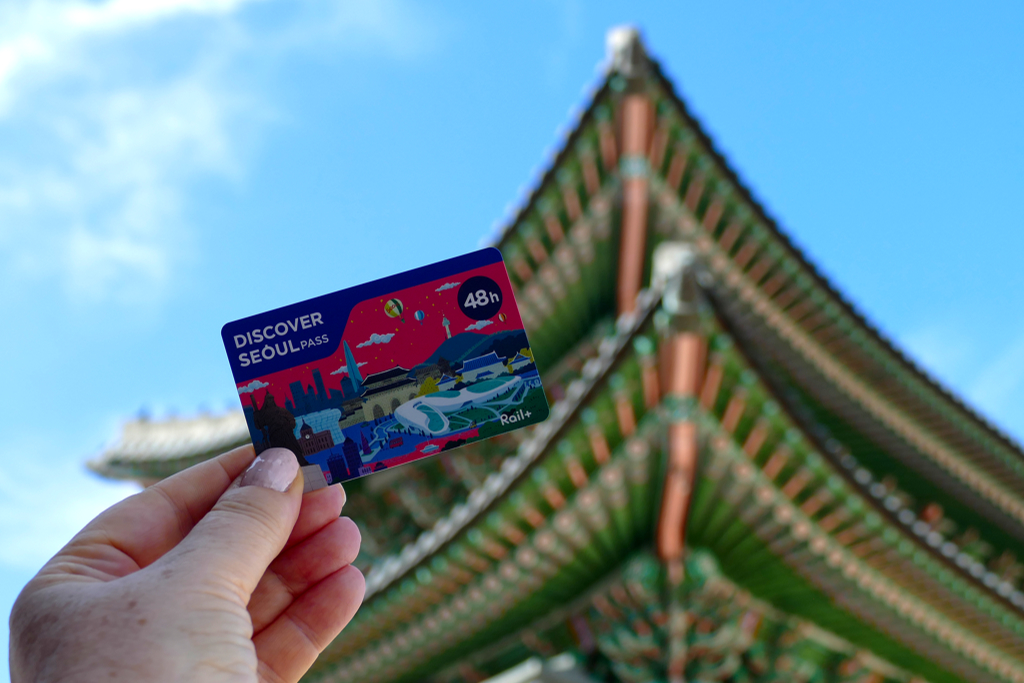
Eventually, you have to charge it with the amount of your choice either at a ticket vending machine or a convenience store. You can top-up the card in units of KR₩ 1,000 up to KR₩ 90,000 at a time. The total deposit cannot exceed KR₩ 500,000. It’s important to know that you cannot top-up by credit card, you have to use cash. Also, I’d recommend topping it up with smaller amounts in case you lose it.
If you don’t use up the credit on your card by the end of your trip, you get a refund at all retail locations. However, they won’t refund the initial price as well as an additional service fee of KR₩ 500.
As I needed both, a SIM card and T-money, I obtained a combined card through GetYourGuide* and picked it up at Incheon International Airport on arrival. Obviously, you can use the T-Money card even after the SIM card expires.
My Tip: It’s not a must, but it is appreciated if you give and receive cards and money with both hands instead of just one hand. Koreans will appreciate this polite gesture, believe me.
Costs And Expenses
I was quite amazed at how inexpensive prices are in South Korea. While accommodation costs depend heavily on the location and are therefore significantly higher in let’s say Seoul than in Andong, for example, you can eat really cheaply and really well throughout the country. A complete meal in an average restaurant costs the equivalent of around 10 euros, but street food is of course even cheaper. Soft drinks and coffee specialties cost a bit less than in Central Europe. You can also get drinking water for free everywhere.
Entrance fees to national landmarks such as palaces and temples are also very cheap – the equivalent of around 1.50 to 3 €uros or USD. Modern attractions such as Instagrammable immersive venues, observation decks, and amusement parks are much more expensive – around ten times the prices of national landmarks.
Therefore, whether a tourist pass is worth it for you depends very much on what you want to see and do. Most likely you will only get the equivalent of what you paid for the pass.
Inner-city public transport costs less than 1 €uro per route. Traveling from place to place by bus or train is also very cheap; only the KTX express trains are a little more expensive. But even these are well below European price levels.
SIM Cards
Just like the question about the T Money Card, I can only say that you can of course travel to Korea without a SIM card. As a matter of fact, you can connect to the internet without any issue at basically every museum, eatery, café, and your hotel, obviously, as well as to open Wi-Fi in many public areas.
However, as I depended so much on a reliable internet connection during my trip, I highly recommend getting your personal data either by a mobile router or a local SIM card. I kid you not, the few moments I for some reason didn’t have an internet connection, I felt like travelling blindfolded.
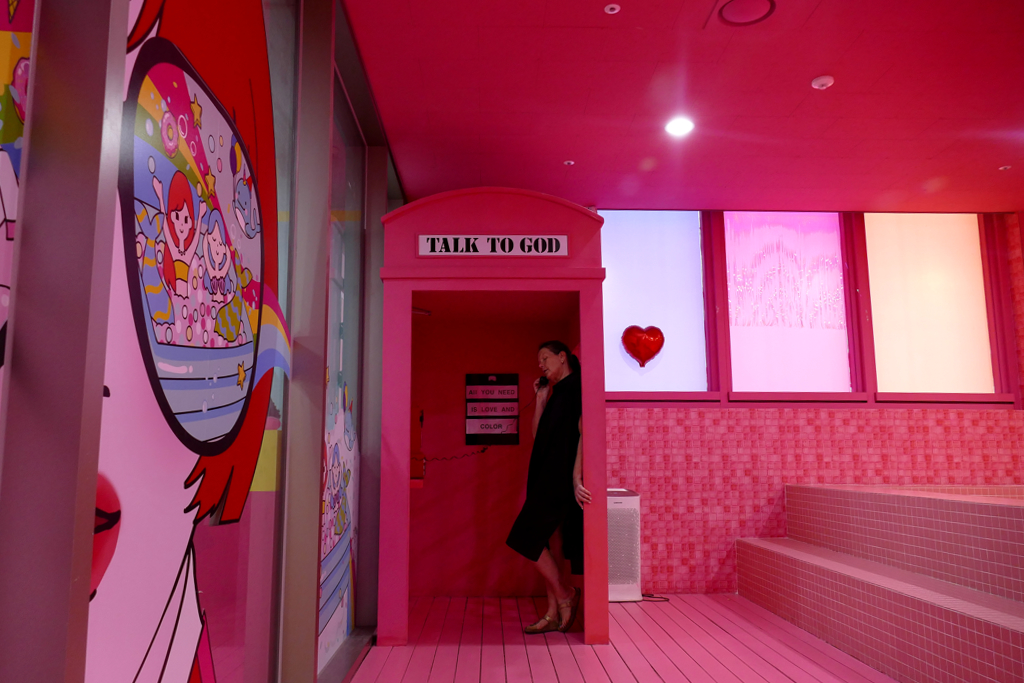
Various companies such as KT Corporation, SK Telecom, and LG U+ offer prepaid SIM cards. I got my card from the latter and loved it. LG U+ offers SIM cards, eSIM, as well as portable Wi-Fi. My card came with a T-money that I obtained through GetYourGuide* and picked up at Incheon International Airport on arrival. For unlimited data, they charge between KR₩ 27,500 for 5 days and KR₩ 99,000 for 40 days. I had the 20 days-version for KR₩ 60,500*.
Plugs and Voltage
Interestingly, in South Korea, just like in many European countries, they use plug types C and F. Their voltage is 220 V, and the frequency is 60 Hz. However, nowadays, in general, all chargers have integrated adapters so that the voltage and frequency don’t really matter.
Indispensible Apps
If you’re not a vagabond who just drifts through space and time with a carefree song on your lips, then at least two of the following apps are not just nice to have but simply indispensable. At least a smoothly working map and a translation app will make your trip so much easier and more enjoyable!
Naver Map
It’s not correct that Google Maps doesn’t work in Korea at all. You can open the App and see where places are. However, it doesn’t give you useful information on public transport and it doesn’t suggest routes. Yet, it recognizes who you are: The blue dot. So while you can check where you are, you cannot plan out routes.
Fortunately, there are two other Apps in Korea, namely Kakao Map and Naver Map. I travelled crisscross Korea with the help of the latter one.
As you can see in the pictures below, Naver works basically just like Google Maps: You type in, from where to where you want to go, specify the date and hour, and choose the means of transportation. Then, Naver does the magic and suggests various options.
However, Naver tends to be patriotic and sometimes transcribes destinations into Hangul so you cannot be sure it actually found the place you were looking for. I solved this problem by verifying Naver’s suggestion on Google Maps.
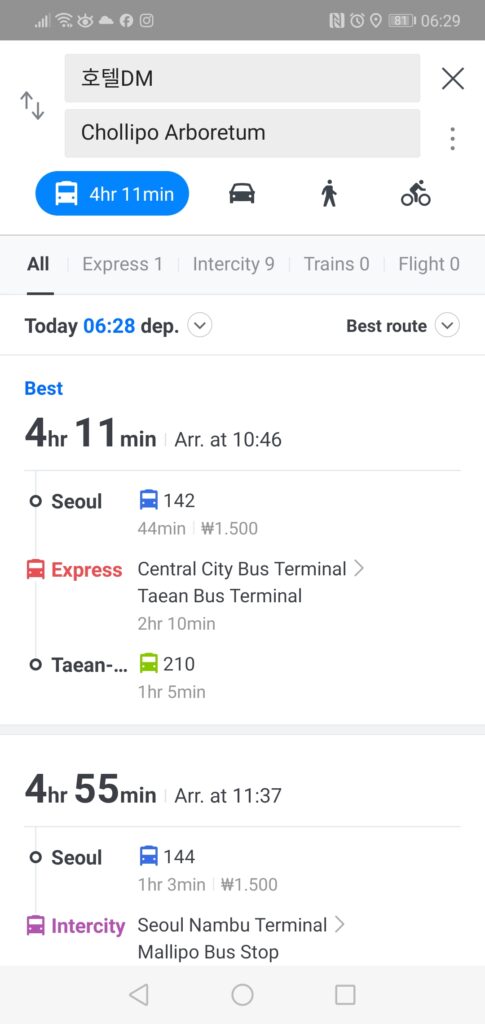
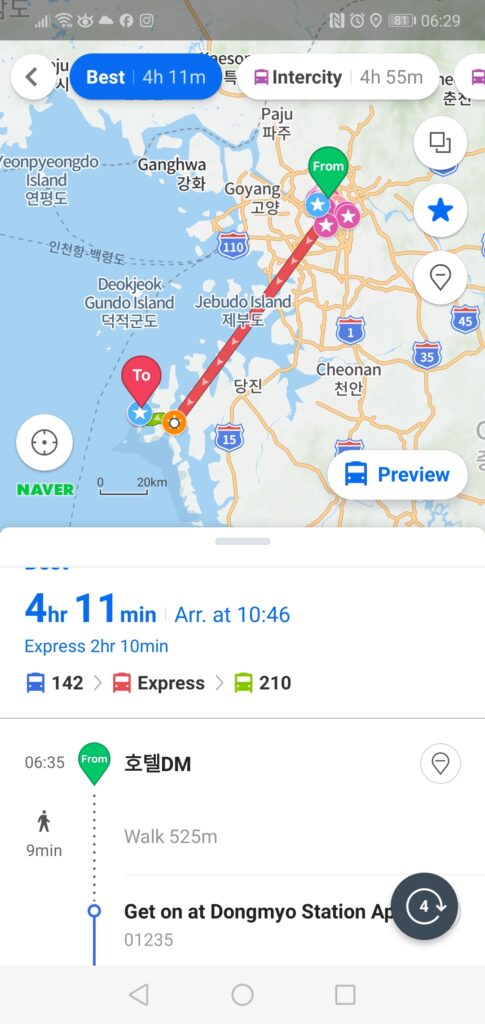

Also, Naver sometimes didn’t show any search results. For instance, if I wrote XYZ restaurant instead of restaurant XYZ. In these situations, I first looked it up on Google Maps, because like I said, it does work insofar as it finds places. Then, I searched for the spot right on Naver’s map. As I found it, I tapped on it on the screen and saved the result for future reference.
Registration Recommended
I set up a free account to save search results. I organized them in folders, you can see them in the second picture.
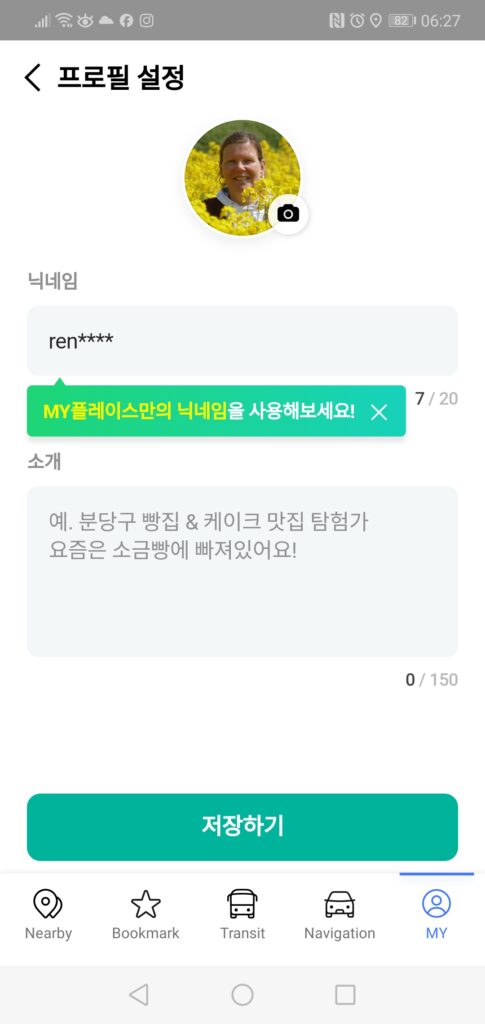
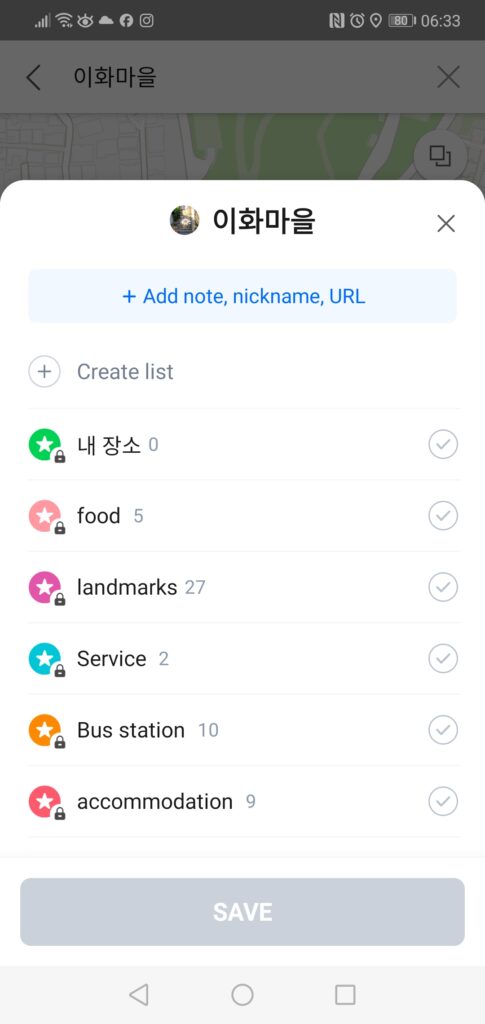
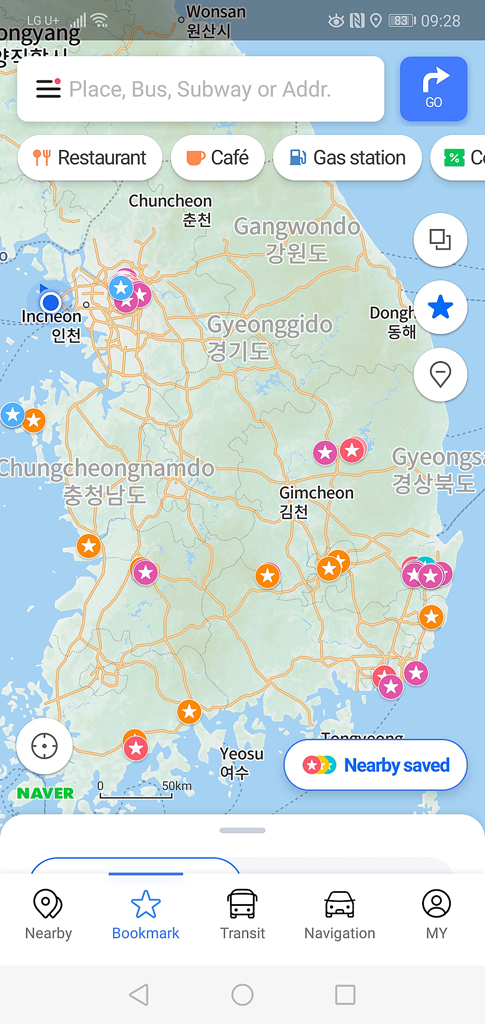
When Naver showed the result in Hangul, I wrote the Latin equivalent in the field for notes before saving. This way, I had the places once and for all in Roman letters, and they also appeared on the map. Eventually, I planned my routes by simply tapping on two marked spots on the map.
You can download the Naver App for Android and for iOS
Microsoft Translator or Naver Papago
Just like it’s a personal preference if you search your way with the help of Naver Map or Kakao Map, it’s totally up to you which translation App you’re using. And even if you don’t choose any of these, most Koreans do have a translator on their phone when they have to deal with foreigners on a regular basis.
For the same reason I chose Naver Map over Kakao Map, I stuck with the Microsoft Translator: I downloaded it first and was happy with it – hence, never change a winning team.
However, both translation Apps offer the same kind of assistance: You can speak, write, or take a picture of a script and the App will translate it.
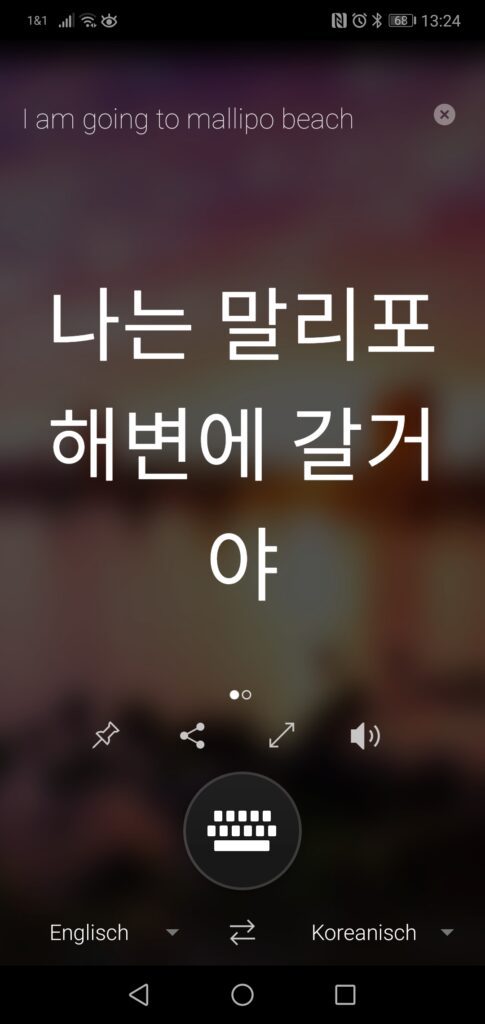


You can download the Microsoft Translator for Android and iOS.
Xe Currency Exchange
Because of its user-friendly operation and quick and easy access to all national currencies, Xe is my favorite currency converter app. You can download it for Android.
Language Barriers
Fair and square: Koreans speak exclusively Korean. And why shouldn’t they? Their country, their language. However, it is quite annoying that even service people at the bus and train stations or the staff in major tourist hotels do hardly speak more than five words of English. Don’t even think about any other language, for that matter.
While in the beginning, I found it quite charming to communicate with people through my translation app – always hoping that the translation would turn out halfway correct and that I wouldn’t insult anyone – after two weeks, it started to get on my nerves that I couldn’t ask even the easiest and most obvious things.
So yes, it’s true, Koreans speak Korean. But fear you not, streets, stations, and many signs are written in English, so you won’t get lost. In Seoul’s subway and in many buses the stops are also announced in English.
It’s a bit quirky that although many restaurants have an English menu, the waiters don’t necessarily speak the language. This means that they won’t understand if you tell them what you’d like to order. Instead, you have to point to it on the menu.
Hence, travelling through Korea is possible even if you don’t speak the language and you’re not familiar with Hangul, the Korean alphabet. Howsoever, I recommend memorizing at least this short list of some of the most common courtesy expressions:
| English | Korean | Pronunciation |
| Hello | annyeonghaseyo | anyonghaseo |
| Bye bye | annyonggiseo | anyonggiso |
| Thank you | gamsahamnida | kamsamida |
| You’re welcome | cheonmaneyo | chonmaneo |
| Please | juseyo | djuso |
| Excuse me | jeogiyo | djokiyo |
| Sorry | joesonghamnida | djusohamida |
| Yes | ne or ye | ne resp. ye |
| No | aniyo | anyo |
My Tip: Koreans pronounce G like K, D like T, and B like P. I’m telling you this so you avoid mispronunciation of cities and places and get what people are talking about when they talk about Kyongju instead of Gyeongju, Teagu instead of Deagu, and Pusan instead of Busan.
If you actually want to learn some more, I can highly recommend the website 90 Day Korean.
Safety
I’m not sure if I would travel with no care in the world to any other country where I don’t have at least some basic knowledge of the language. Not being able to understand, being unable even to read or at least make out letters adds to insecurity and therefore vulnerability which, I believe, makes you a victim.
As I pointed out above, South Korea is an exceptionally safe country. It is highly improbable that you will fall victim to petty crime. No one seems interested in stealing your bags or pickpocketing your wallet.
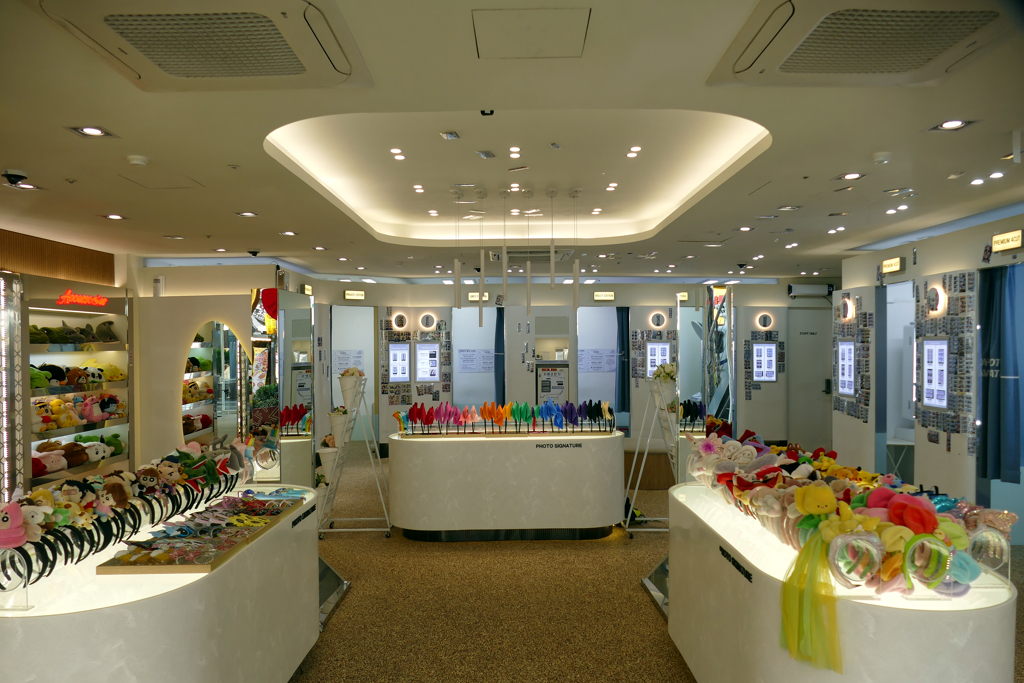
The fact that practically no precautions are taken to protect objects in public spaces proves how safe Korea really is.
A great example is photo booths, which are all the rage in Korea. They are beautiful shops equipped with dressing tables and all sorts of toiletries. There are also shelves full of fun props like hair clips, hats, glasses, beards, and many other accessories that you can use for your pictures.
Hard to believe, but these well-equipped shops are mostly unmanned. Hence, anyone can walk in and dress up as they please. Yes, there may be a little security camera in the corner – but when has that ever stopped someone from shoplifting? Apparently in Korea, they don’t expect anyone to steal or vandalize.
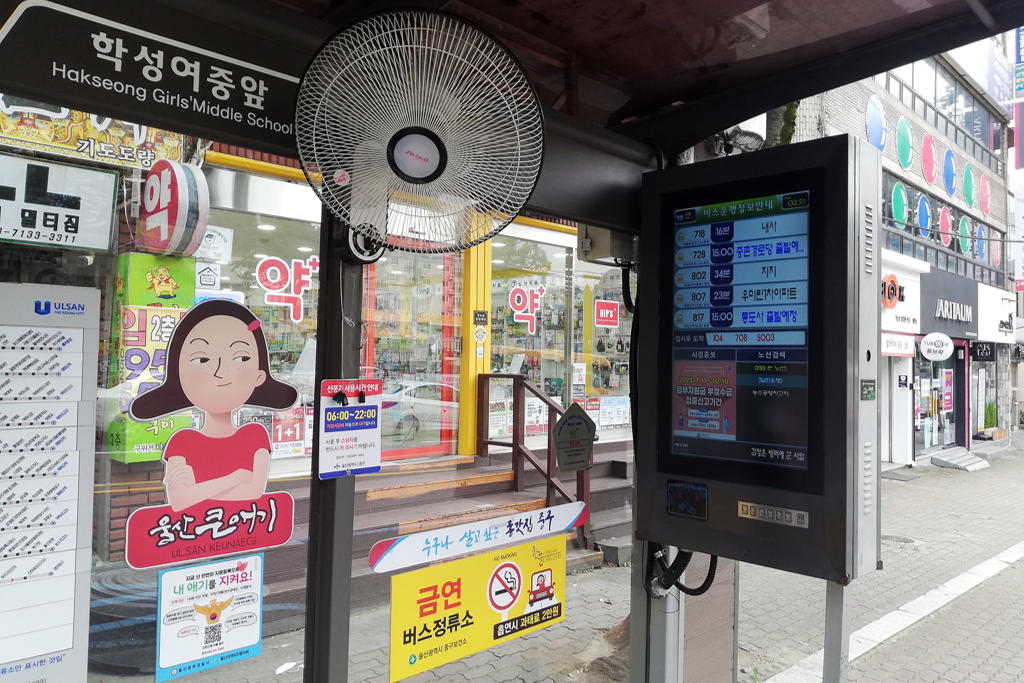
Honestly, I would like to live in a society like that anytime, anywhere!
Gastronomy Etiquette
Now we finally do get to something Korea and Japan have largely in common, and that is table manners.
No Shoes
First things first: Check if you have to take your shoes off before entering a specific restaurant. This isn’t necessary everywhere, but in traditional teahouses and eateries, the owners literally freak out if you enter the dining room in shoes.

If you’re unsure, just peek in the door and ask. Do not take a single step into an establishment in shoes if you are unsure whether they are allowed.
Wait to be Seated
Other than in many European countries, you don’t storm into a restaurant and throw yourself on the most appealing table. I know waiting to be seated is normal in the US. However, in many European countries, this is not always the case.
Help Yourself
In most restaurants, the waiter doesn’t bring you the cutlery. Instead, it’s already there: Either in a container on the table or there is a drawer where you find chopsticks, spoons, and paper napkins. By the way, Korean chopsticks are made from metal. Only the to-go version is made from wood.
Just like in Japan, it’s an absolute no-no to ram your chopsticks into rice or any other food. Sticking chopsticks vertically into a bowl of rice is part of a funeral ceremony and extremely disturbing for Koreans.

Oftentimes, there is either a jug with fresh drinking water on your table or there is a water dispenser anywhere in the restaurant where you can get your own. In some restaurants, however, the waiter will bring you a pitcher. This water is free of charge, obviously. I know this is normal in the US, but not necessarily in the rest of the world.
By the way, if you are having drinks with Koreans, never fill your own glass. You pour everyone else’s drinks and someone will then take care of yours.
Contrary to the US, the waiter does not come until you give him a sign. If you order at a counter, they will supply you with one of these flashing thingies that goes off as soon as your food is ready for pickup.
Paying Yea, Tipping Nay
Korea has no tipping culture. Everything is priced as marked. Hence, not only is the tax included, but also the service respectively the gratuities. On the contrary: If the owner of the eatery likes you, you’ll even get some goodies like a complimentary starter or dessert.
In most Korean restaurants, you don’t pay your waiter. Once you’re done with your meal, you pay at a cash register, even if the waiter didn’t leave the check on your table. Don’t worry, they’ll know exactly what you had. This makes things less awkward for us who are used to tipping. Tipping is not customary, and I would really feel very uncomfortable handing the waiting person the exact amount respectively accept change.
Paying at the cash register gives the whole process more of a supermarket feel.
Ground Rules of Etiquette
No Tissue
Some of the basic rules of etiquette are also almost identical in Korea and other Asian countries. For instance, you shouldn’t blow your nose in public – and most importantly, not noisily! As a matter of fact, for me, this rule is the hardest one to follow. Especially since Korean food is often really spicy which makes my nose run nonstop.
However, in Asia, blowing your nose is like spitting snot or farting or…doing something really gross. In brief: Simply disgusting.
On the other hand, snuffling is acceptable. That would be something I personally find really, really gross. But I’m European.
So, like they say: When in Korea, do as the Koreans do!
Snuffle as much as you please, but don’t blow your nose in public.
No Shoes
Another major no-no is shoes in private spaces. While Korea is by far not the only country where it’s customary – I would go so far as to call it crucial – to take your shoes off when entering a private home, Koreans, take it to a whole different level: There are not only temples and other sacred places where you have to take your shoes off, but also stores, tea houses, and restaurants.
No Jaywalking
As I admitted above, I’m a very impatient person. If I have to wait for two minutes, I feel like wasting my entire life away. Waiting at a traffic light is no exception to this; nevertheless, I should point out that I’m a pedestrian, not a driver.
Hence, the only person I put in danger by not respecting traffic lights all the time is me.
Now in Japan, this is unthinkable no matter what.
If you have to cross a narrow sidestreet at four in the morning in a small town – you are expected to wait for the green light. No matter what.
Travelling Around
Travelling crisscross South Korea is inexpensive, super-easy, and comfortable, despite all the language barriers.
The rail network connects practically all major cities. You can buy reasonably priced tickets at the railway station from vending machines as well as real people and supposedly on the internet. Nevertheless, some fellow travellers told me that they couldn’t pay online with their international credit cards. I don’t know for sure since I always bought my tickets right before departure at the station.
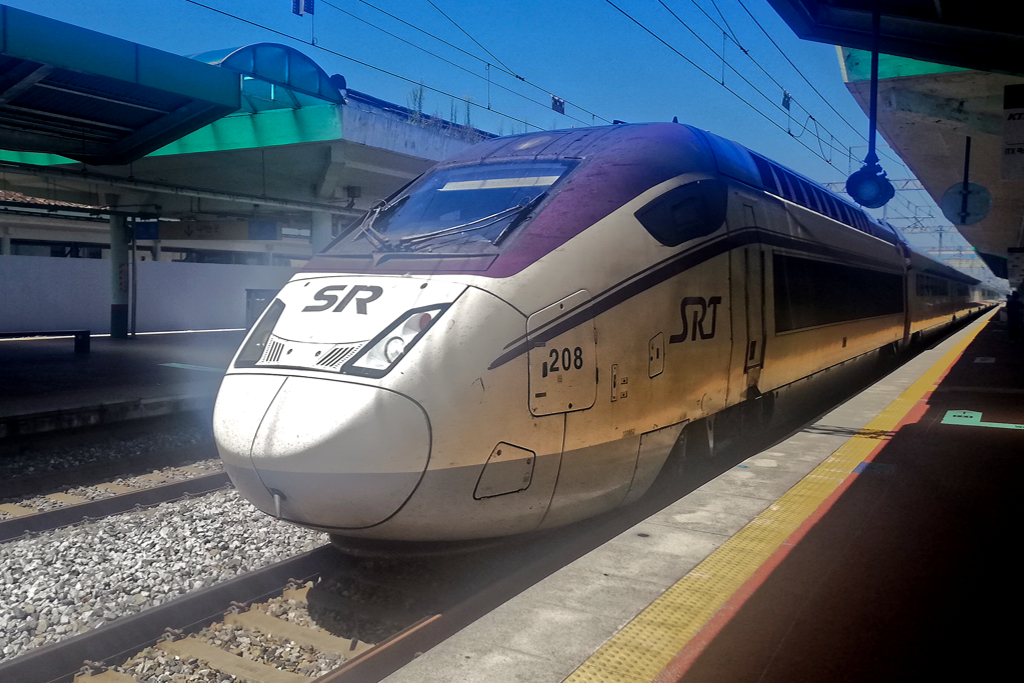
For the sake of completeness, it should be mentioned that tourists can also obtain the KORAIL Pass. However, I cannot even imagine how much time you have to spend on those trains to get your money’s worth out of them. The cheapest pass costs KR₩ 121,000 for two consecutive days. In comparison, I paid KR₩ 21,000 for a KTX ticket all the way from Andong to Seoul.
However, if you do not buy your ticket well in advance, it may happen that there are no more seats available. Does this necessarily mean you have to stand for hours?
Well, if you play it smart, you don’t.
Get Up, Stand Up – How to Survive a Standing Ticket on a KTX Train
So, how can you still secure a seat?
First of all, you should be at the station very early and try to be among the first to board the train. This works best when you are boarding at the starting station, obviously. You can then grab one of the foldable seats that are mounted in the small spaces between the train carriages.
However, you can also just grab one of the seats that remain vacant for a period of time as the passengers may only board the train at the following stations. However, you’ll have to give those seats up as the rightful seat owner boards the train.
Obviously, those standard seats are much more comfortable than the folding ones. However, there is a high risk of having to give them up again very soon.
When my train left Andong half-empty, I was tempted to sit down in one of those comfortable seats, obviously. But then I saw that the train would stop at seven stations before it reached Seoul. If I were evicted from my seat, my slightly more uncomfortable folding seat would certainly be taken and I would have to stand for the rest of the journey. Two and a half hours in an upright position is a long time.
Intercity Bus
However, I took the train only twice during my entire three weeks in Korea as the bus stations were often more conveniently located. Also, I went to places where there were no train stations.
For travel between cities, towns, and villages, so-called Express and Intercity buses are a great option. They are fast, clean, and comfortable. Fares vary a bit depending on the bus type and the time of the day. However, in comparison with other countries, they are always rather cheap.
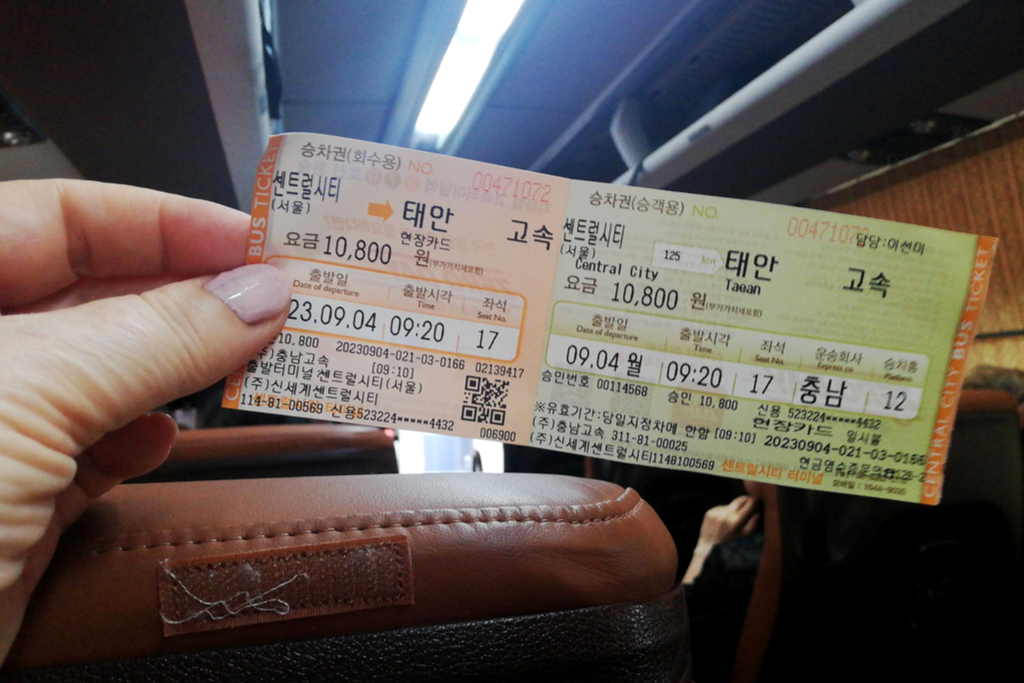
You can buy tickets right at the bus terminals from vending machines or very helpful clerks. A shoutout to all the lovely ladies who recommended connections and explained to me what to do despite their lack of English.
Keep in mind that Express buses and Intercity buses depart oftentimes from different terminals. However, if you search for the best route on Naver, the App will lead you to the correct hub.
Inner-City Transport
Inner-city transport across South Korea is bliss! There is a reliable bus service everywhere, and in some major cities also comprehensive subway networks. Normally, single trips cost less than KR₩ 1,400 and you can pay cash. However, paying with your T-Money card is easier and faster, and you also save a bit.
There are marked seats for elderly passengers, and people do respect that. Curiously, they keep only these seats available. By no means do people get up to offer their regular seats to the passengers who need them more. Regarding all other seats, it’s the survival of the fittest. As a matter of fact, I’ve seen young girls quickly beeline their way past three grandmas to get the only available seat before them. Yes, the seat wasn’t designated for the old and weak, but still – how is that respectful?
Also, there are particular seats for pregnant women. Interestingly, these are generally respected by non-pregnant women. But you wouldn’t believe how many men I’ve seen sitting there – and I presume they were not pregnant.
Yes, men in Korea take up a lot of space. It’s a man’s man’s man’s world. I didn’t just learn this from Korean YouTubers and Korean authors, I saw it with my own eyes.
While talking on public transport is not totally taboo, you should keep conversations – also on the phone – as short as possible and most importantly keep your voice down.
What to Know When Visiting a Korean SPA
An important element of Korean culture is the so-called Jjimjilbang. A Jjimjilbang is a public bathhouse consisting of traditional saunas and pools. The pool area is called Mogyoktang. Here, everyone is completely naked, separated by gender. After a thorough shower, you relax in pools filled with warm thermal water.
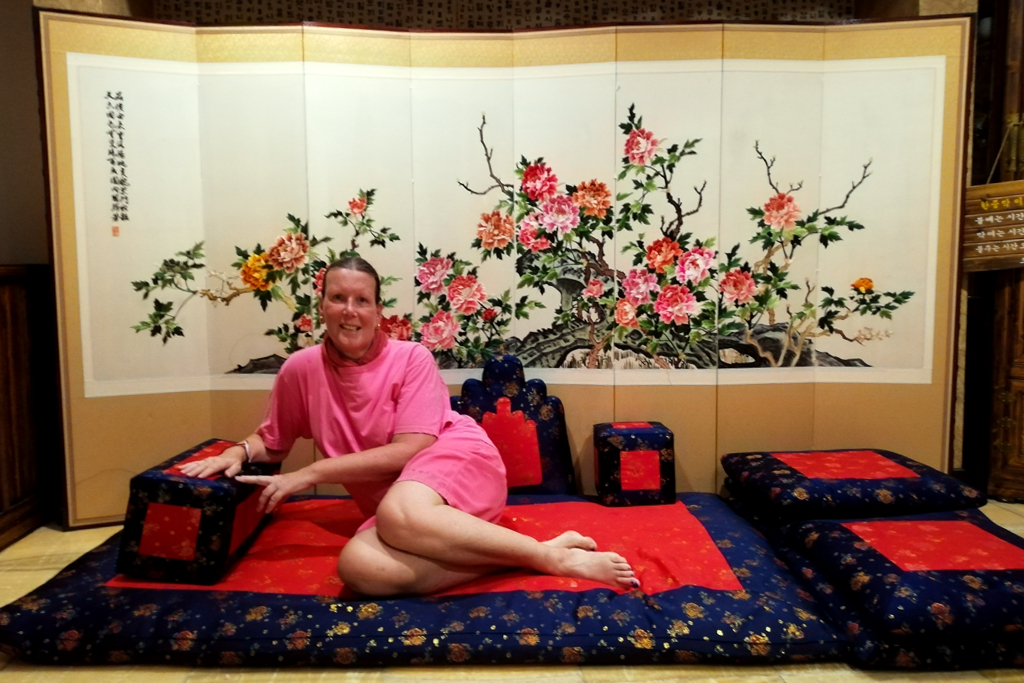
There is also a dry area that both sexes use together. It consists of saunas, relaxation areas, gaming stations, cafeterias, and other facilities. In these areas, you have to wear a set of clothing the SPA provides.
The Jjimjilbang’s facilities are designed for leisure and relaxation. Therefore, it is unsurprising that some establishments even allow customers to sleep there overnight. When visiting a traditional Korean bathhouse, you have to follow certain procedures and some very strict rules. Therefore, I have put together a guide All you need to know before visiting a Korean Spa. This way, you don’t make any mistakes even as a first-time visitor.
By the way, much to my disdain, only men can visit the SPAs and saunas in many Korean hotels. It’s definitely time for Korea to arrive in the 21st century.
Bathrooms Everywhere
One facility that is important for travellers but oftentimes difficult to find or access are public lavatories. I usually stick to department stores and malls to go to the bathroom when I travel. In Amsterdam I even visited a museum just for that purpose. It should be mentioned that I had a tourist card and therefore free entry.

So while looking for a restroom in other countries can be a challenge, South Korea could also be called – with the greatest admiration and by no means disrespectfully – the land of a thousand toilets. Clean, intact, free washrooms are found everywhere. I’m not just talking about big cities and small towns, rest stops, and similar places where you actually expect a lavatory. No, public toilets in perfect condition are also located next to hiking trails, on beaches, and in forests.
Yes, the range of public restrooms available to the Korean population and the country’s visitors is so impressive that it deserves its own chapter in this post!
This Is Not Japan
Especially when talking to elder people, don’t compare Korea to Japan and also avoid praising Nippon’s glories. For decades, Japan occupied and colonized Korea partly in a gruesome way. Especially older Koreans hold a grudge mainly because Japan has never admitted its guilt and the war crimes. Therefore, you better avoid comparing both countries, even in aspects where Korea does better.
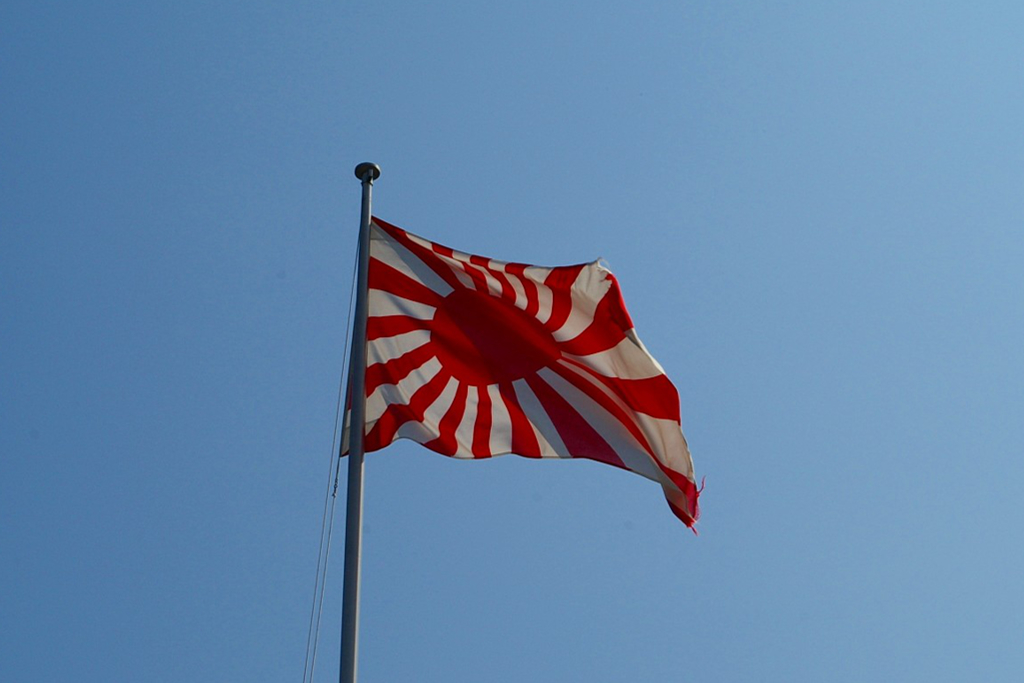
(Photo: en:Tokyo Watcher, Rising sun flag, cropped 3:2, CC BY-SA 3.0)
Also, check your t-shirts and hoodies for the Japanese Rising Sun Flag. Just like you might not want to wave a Russian flag in Ukraine, you shouldn’t show this Imperial war symbol of Japan in Korea. As a matter of fact, the Rising Sun flag is akin to a symbol of military terror towards Asians just like how the swastika flag is a symbol of Nazi horrors in Europe.
Anything Else?
So this is my list of helpful information and tips that should make your trip to South Korea smooth and fun.
Have you been to South Korea?
Which cultural differences have you noticed there?
If you have something to add – hit me, I and the other readers will be grateful for helping to make this list more complete.
In my post Grand Tour of SOUTH KOREA – A Guide for Individual First-Time Visitors, you can read about all the beautiful places I’ve visited during my recent trip to the so-called Land of Morning Calm.
Pinnable Pictures
If you choose to pin this post for later, please use one of these pictures:
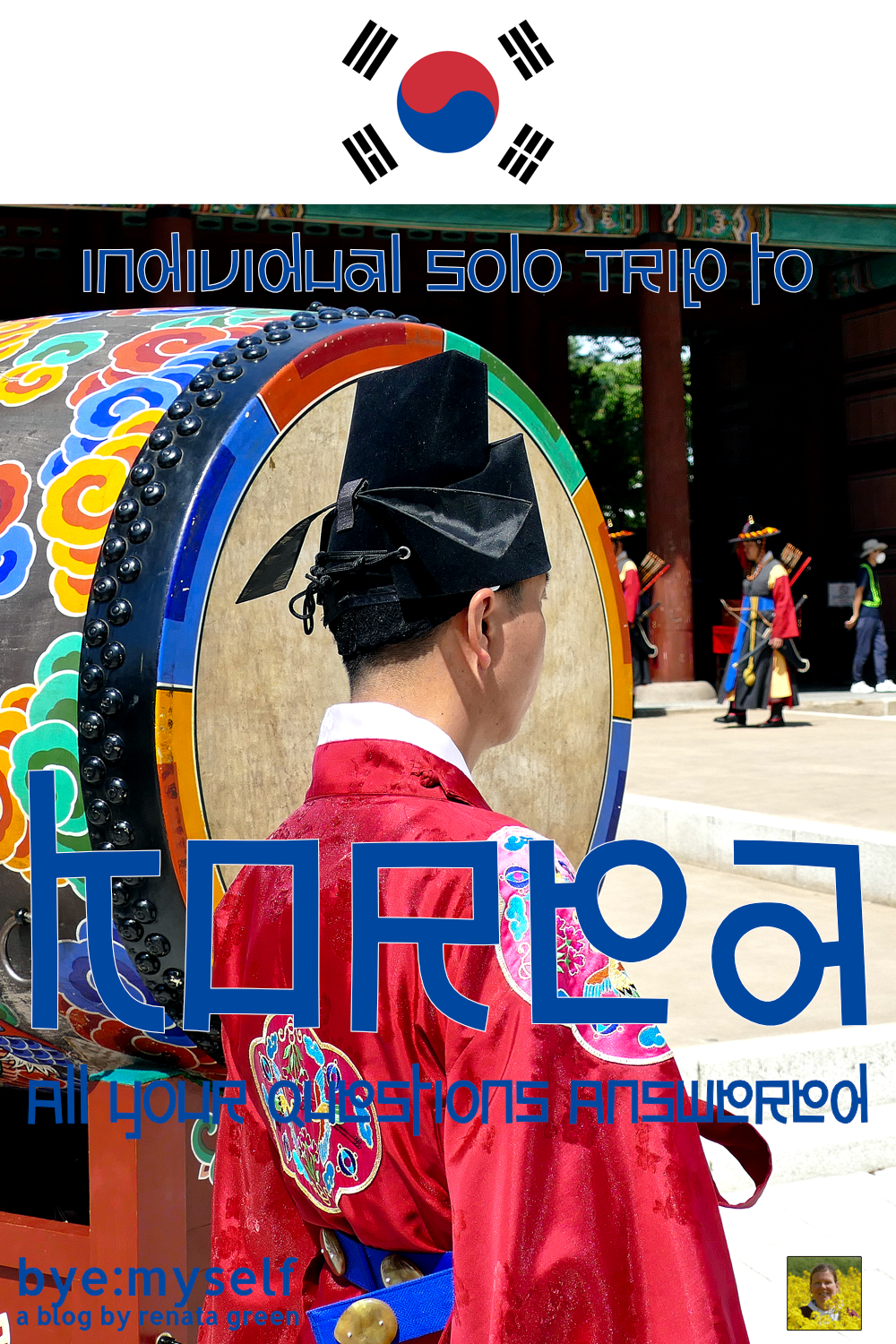
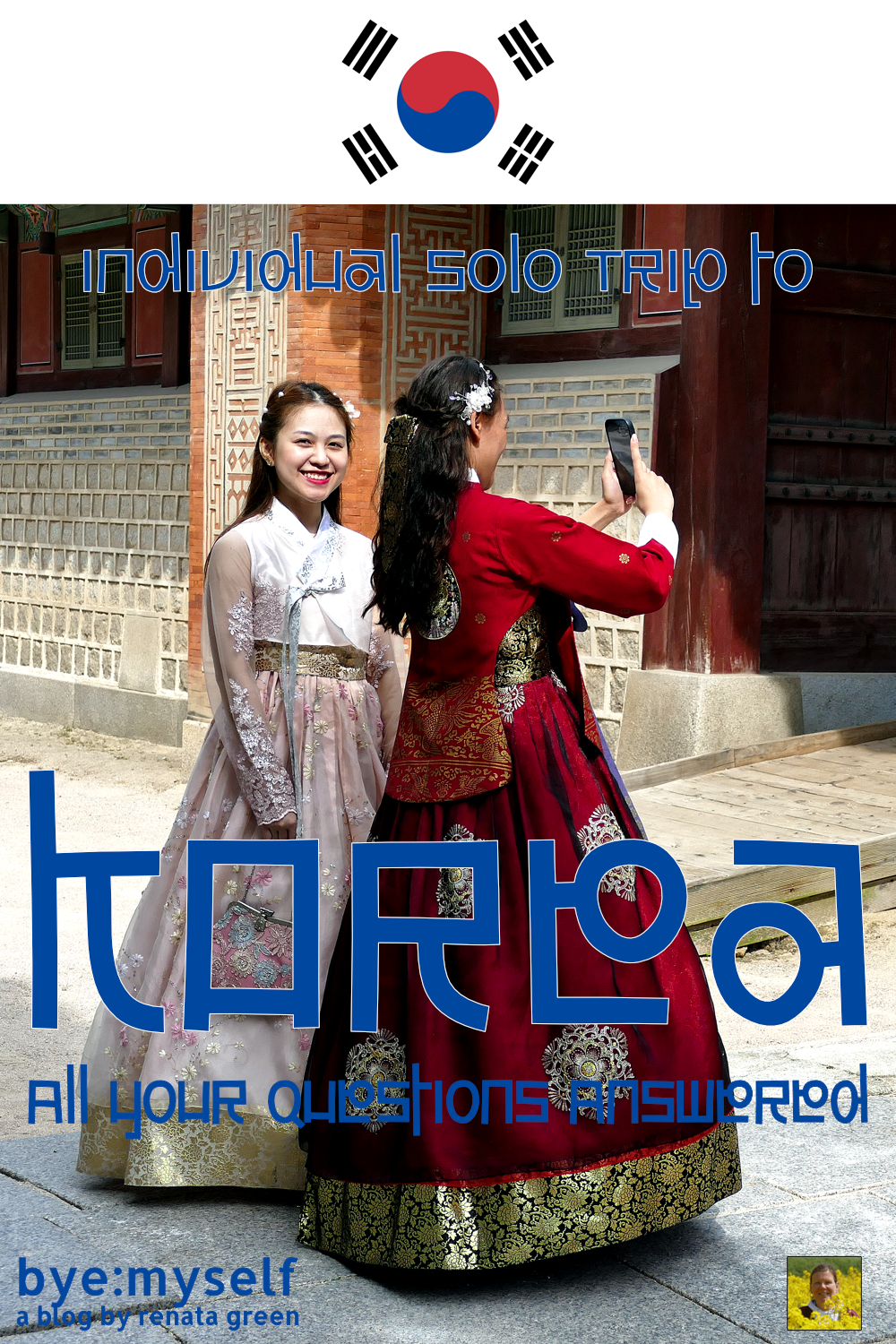
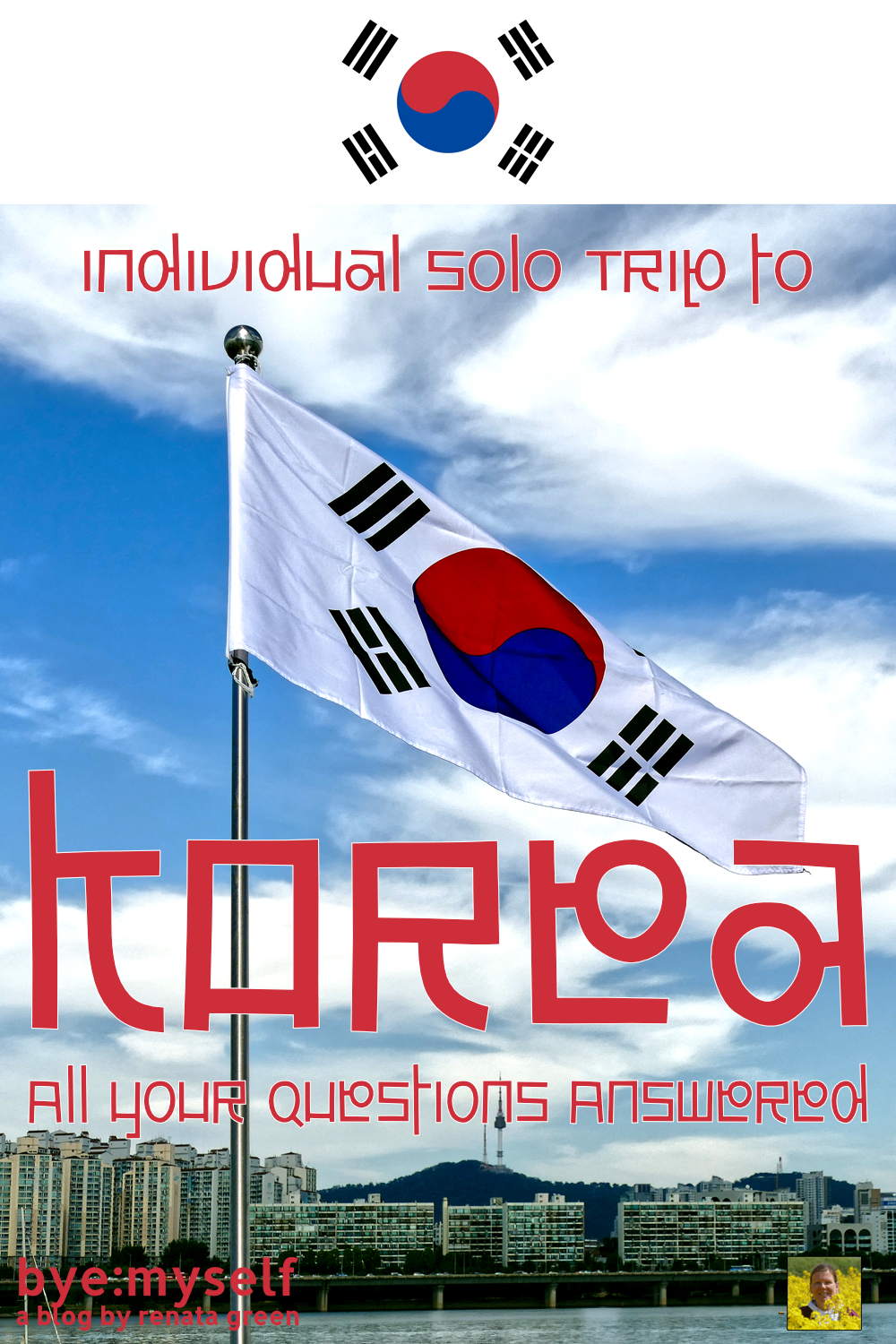
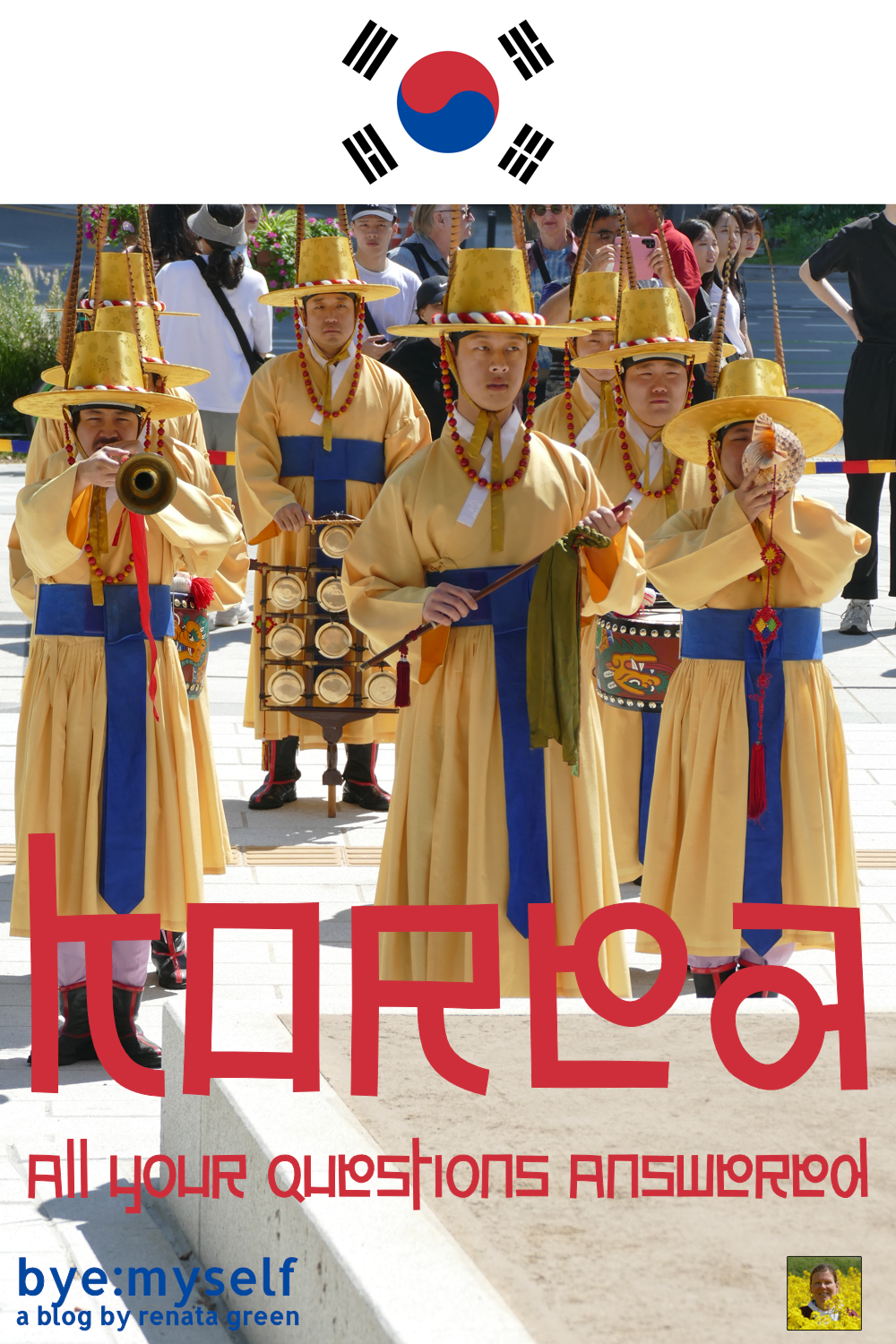
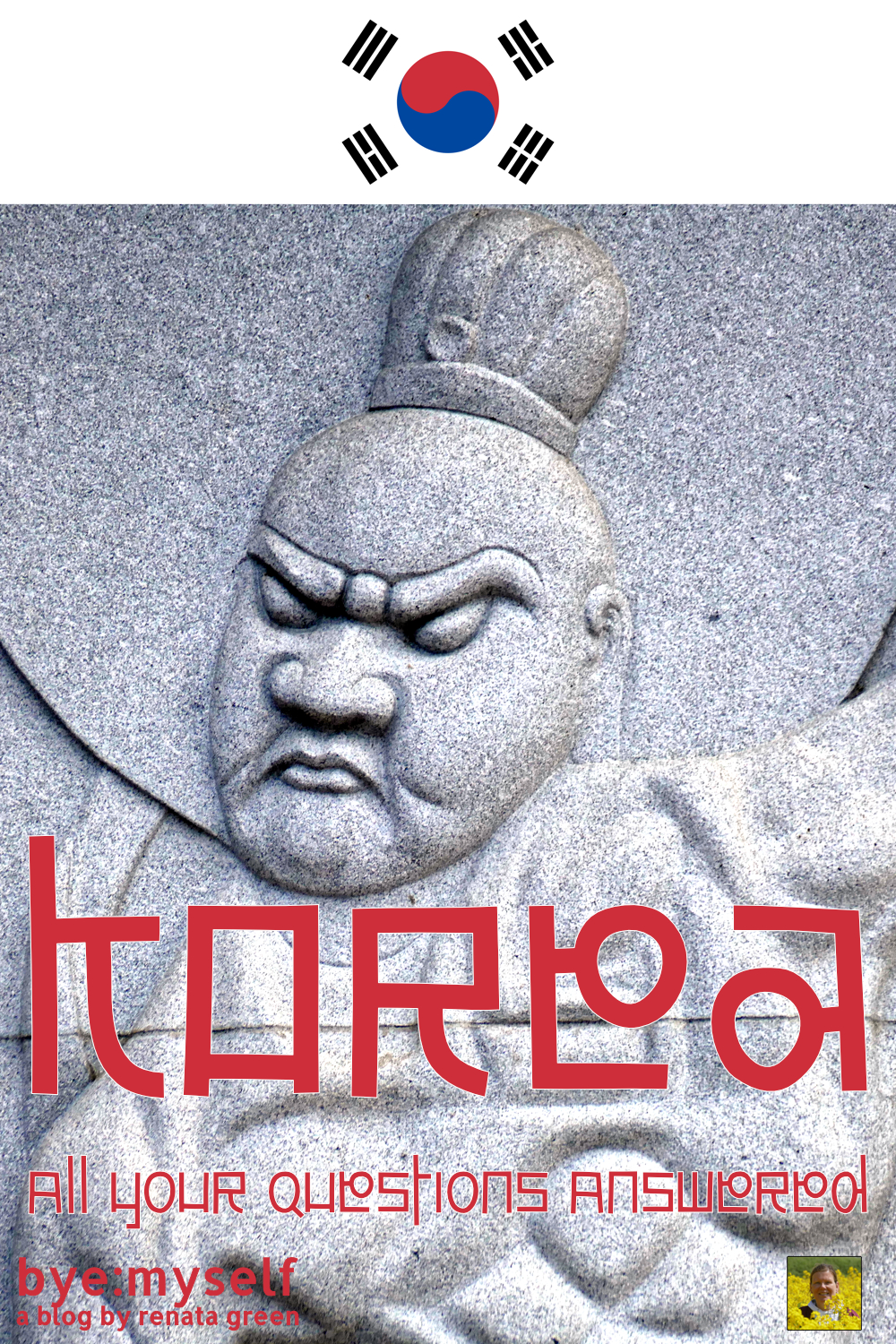
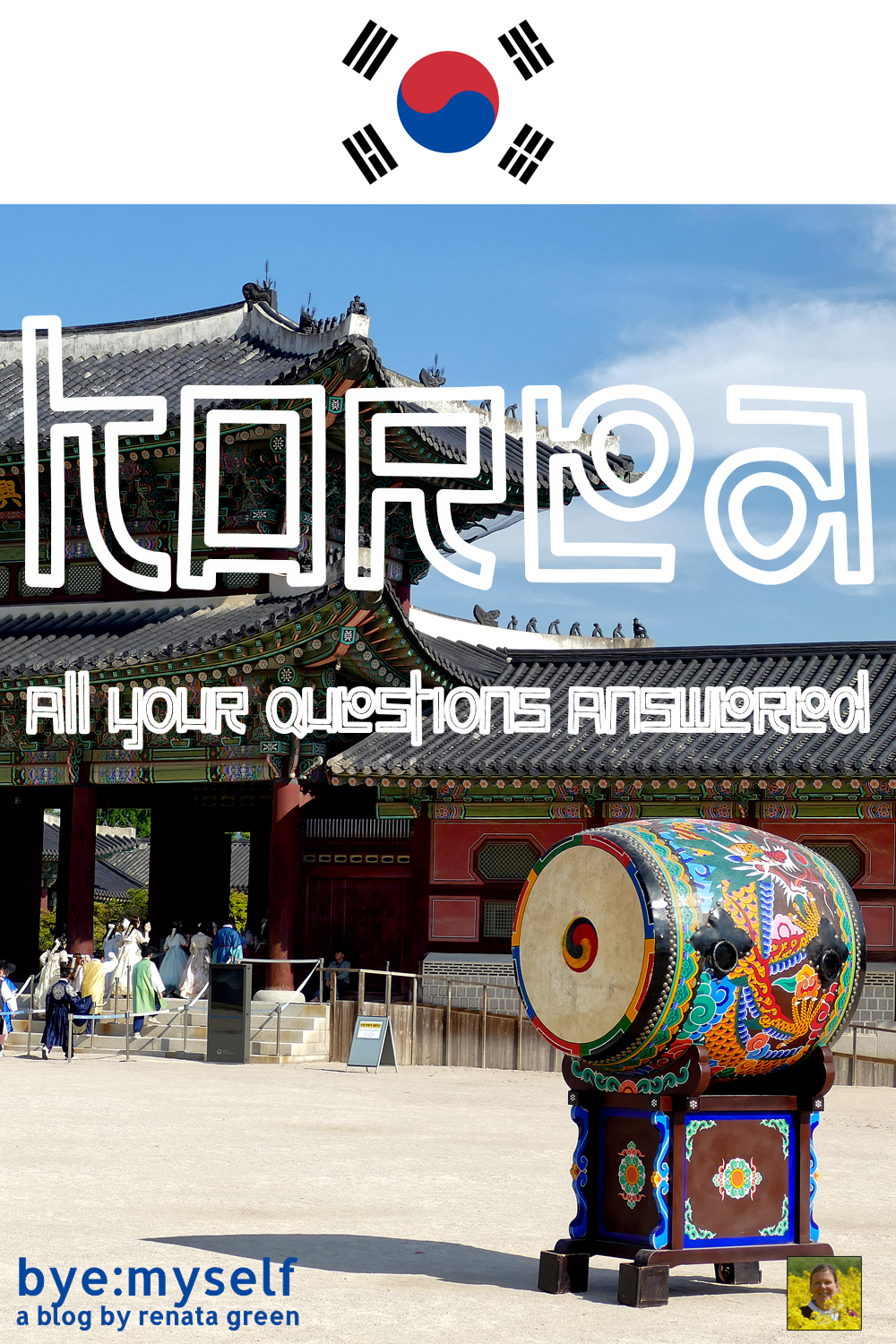
Did You Enjoy This Post? Then You Might Like Also These:
Culture Villages in Korea: Real People, Real Art
Mallipo Beach And Chollipo Arboretum: Korea’s Perfect Getaway
All You Need to Know Before Visiting a Korean Spa
Green Tea Plantations Around BOSEONG: Totally My Cup Of Tea!
Grand Tour of SOUTH KOREA – A Guide for Individual First-Time Visitors
Individual Solo Trip to KOREA – All Your Questions Answered
An Easy Day Trip to the Hahoe Folk Village from Andong
Best And Most Beautiful Bookstores in Seoul
* This is an affiliate link. Hence, If you book through this page, not only do you get the best deal. I also get a small commission that helps me run this blog.
Thank you so much for supporting me!


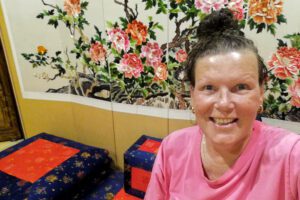


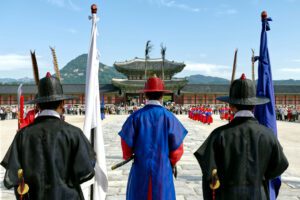
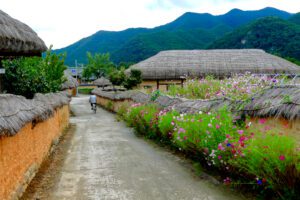
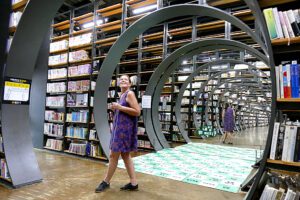
I love how this blog celebrates diversity and inclusivity It’s a reminder that we are all unique and should embrace our differences
Thank you for your kind words, Lamar!